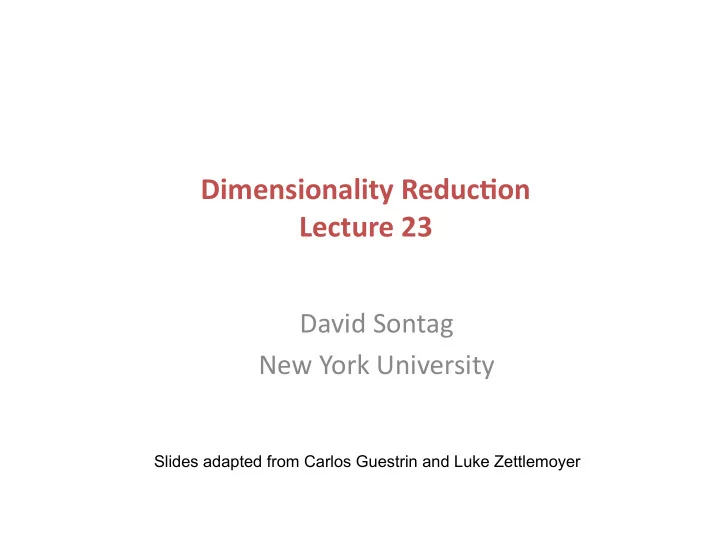

Dimensionality ¡Reduc1on ¡ Lecture ¡23 ¡ David ¡Sontag ¡ New ¡York ¡University ¡ Slides adapted from Carlos Guestrin and Luke Zettlemoyer
Assignments ¡ • Last ¡homework ¡assignment ¡released ¡tonight, ¡ due ¡next ¡Thursday ¡(Dec. ¡5) ¡ • Final ¡project ¡write-‑up ¡due ¡December ¡15 ¡ • 10 ¡minute ¡presentaJons ¡(1 ¡per ¡group) ¡ – Part ¡of ¡your ¡grade ¡ – During ¡final ¡exam ¡period, ¡Dec. ¡17, ¡10-‑11:50am ¡ • I ¡need ¡4 ¡groups ¡to ¡volunteer ¡to ¡give ¡their ¡ presentaJon ¡on ¡Dec. ¡12 ¡ 2
Dimensionality ¡reducJon ¡ • Input ¡data ¡may ¡have ¡thousands ¡or ¡millions ¡of ¡ dimensions! ¡ – e.g., ¡text ¡data ¡has ¡???, ¡images ¡have ¡??? ¡ ¡ • Dimensionality ¡reduc1on : ¡represent ¡data ¡with ¡ fewer ¡dimensions ¡ – easier ¡learning ¡– ¡fewer ¡parameters ¡ – visualizaJon ¡– ¡show ¡high ¡dimensional ¡data ¡in ¡2D ¡ – discover ¡“intrinsic ¡dimensionality” ¡of ¡data ¡ • high ¡dimensional ¡data ¡that ¡is ¡truly ¡lower ¡dimensional ¡ ¡ • noise ¡reducJon ¡
!"#$%&"'%()$*+,-"'% � .&&+#/-"'%0(*1-1(21//)'3"#1-$456(4"$&('%( 1(4'7$)(*"#$%&"'%14(&/1,$ � 831#/4$&0 Slide from Yi Zhang
Lower ¡dimensional ¡projecJons ¡ • Rather ¡than ¡picking ¡a ¡subset ¡of ¡the ¡features, ¡we ¡can ¡ obtain ¡new ¡ones ¡by ¡combining ¡exisJng ¡features ¡x 1 ¡… ¡x n ¡ z 1 = w (1) w (1) ⌥ + x i ⌥ 0 i … i z k = w ( k ) w ( k ) ⌥ + x i 0 i i • New ¡features ¡are ¡linear ¡combinaJons ¡of ¡old ¡ones ¡ • Reduces ¡dimension ¡when ¡k<n ¡ • Let’s ¡consider ¡how ¡to ¡do ¡this ¡in ¡the ¡unsupervised ¡ se]ng ¡ ¡ – just ¡ X , ¡but ¡no ¡Y ¡
Which ¡projecJon ¡is ¡be_er? ¡ From notes by Andrew Ng
Reminder: ¡Vector ¡ProjecJons ¡ • Basic ¡definiJons: ¡ – A.B ¡= ¡|A||B|cos ¡θ ¡ – cos ¡θ ¡= ¡|adj|/|hyp| ¡ ¡ • Assume ¡|B|=1 ¡(unit ¡vector) ¡ – A.B ¡= ¡|A|cos ¡θ ¡ – So, ¡dot ¡product ¡is ¡length ¡of ¡ projecJon!!! ¡
Using ¡a ¡new ¡basis ¡for ¡the ¡data ¡ • Project ¡a ¡point ¡into ¡a ¡(lower ¡dimensional) ¡space: ¡ – point : ¡ x ¡ = ¡(x 1 ,…,x n ) ¡ ¡ – select ¡a ¡basis ¡– ¡set ¡of ¡unit ¡(length ¡1) ¡basis ¡vectors ¡ ( u 1 ,…, u k ) ¡ • we ¡consider ¡orthonormal ¡basis: ¡ ¡ – u i • u i =1, ¡and ¡ u i • u j =0 ¡for ¡i ≠ j ¡ – select ¡a ¡center ¡– ¡ x , ¡defines ¡offset ¡of ¡space ¡ ¡ – best ¡coordinates ¡ in ¡lower ¡dimensional ¡space ¡ defined ¡by ¡dot-‑products: ¡(z 1 ,…,z k ), ¡z j ¡= ¡( x -‑ x ) • u j ¡
Maximize ¡variance ¡of ¡projecJon ¡ Let x (i) be the i th data point minus the mean. Choose unit-length u to maximize: m m 1 1 ( x ( i ) T u ) 2 u T x ( i ) x ( i ) T u � � = m m i =1 i =1 � � m 1 x ( i ) x ( i ) T � u T = u. m i =1 Let ||u||=1 and maximize. Using the method of Lagrange multipliers, can show that the solution is given by the principal eigenvector of the covariance matrix! (shown on board)
Basic ¡PCA ¡algorithm ¡ • Start ¡from ¡m ¡by ¡n ¡data ¡matrix ¡ X ¡ • Recenter : ¡subtract ¡mean ¡from ¡each ¡row ¡of ¡ X ¡ – X c ¡ ← ¡X ¡– ¡X ¡ • Compute ¡covariance ¡ matrix: ¡ – ¡ Σ ¡ ← ¡ 1/m ¡X c T ¡X c ¡ • Find ¡ eigen ¡vectors ¡and ¡values ¡ of ¡ Σ ¡ ¡ • Principal ¡components: ¡k ¡eigen ¡vectors ¡with ¡ highest ¡eigen ¡values ¡
PCA ¡example ¡ Data: Projection: Reconstruction:
Dimensionality ¡reducJon ¡with ¡PCA ¡ In high-dimensional problem, data usually lies near a linear subspace, as noise introduces small variability Only keep data projections onto principal components with large eigenvalues Can ignore the components of lesser significance. 25 20 Variance (%) 15 10 5 0 PC1 PC2 PC3 PC4 PC5 PC6 PC7 PC8 PC9 PC10 You might lose some information, but if the eigenvalues �������������������������� much 23 Slide from Aarti Singh
Eigenfaces ¡ [Turk, ¡Pentland ¡’91] ¡ • Input ¡images: ¡ Principal components:
Eigenfaces ¡reconstrucJon ¡ • Each ¡image ¡corresponds ¡to ¡adding ¡together ¡ (weighted ¡versions ¡of) ¡the ¡principal ¡ components: ¡
Scaling ¡up ¡ • Covariance ¡matrix ¡can ¡be ¡really ¡big! ¡ – ¡ Σ ¡is ¡n ¡by ¡n ¡ – 10000 ¡features ¡can ¡be ¡common! ¡ ¡ – finding ¡eigenvectors ¡is ¡very ¡slow… ¡ • Use ¡singular ¡value ¡decomposiJon ¡(SVD) ¡ – Finds ¡k ¡eigenvectors ¡ – great ¡implementaJons ¡available, ¡e.g., ¡Matlab ¡svd ¡
SVD ¡ • Write ¡ X ¡= ¡W ¡S ¡V T ¡ – X ¡ ← ¡data ¡matrix, ¡one ¡row ¡per ¡datapoint ¡ – W ¡ ← ¡weight ¡matrix, ¡one ¡row ¡per ¡datapoint ¡– ¡ coordinate ¡of ¡ x i ¡in ¡eigenspace ¡ ¡ – S ¡ ← ¡singular ¡value ¡matrix, ¡diagonal ¡matrix ¡ • in ¡our ¡se]ng ¡each ¡entry ¡is ¡eigenvalue ¡ λ j ¡ – V T ¡ ← ¡singular ¡vector ¡matrix ¡ • in ¡our ¡se]ng ¡each ¡row ¡is ¡eigenvector ¡ v j ¡
PCA ¡using ¡SVD ¡algorithm ¡ • Start ¡from ¡m ¡by ¡n ¡data ¡matrix ¡ X ¡ • Recenter : ¡subtract ¡mean ¡from ¡each ¡row ¡of ¡ X ¡ – X c ¡ ← ¡X ¡– ¡X ¡ • Call ¡SVD ¡ algorithm ¡on ¡ X c ¡– ¡ask ¡for ¡k ¡singular ¡ vectors ¡ • Principal ¡components: ¡k ¡singular ¡vectors ¡with ¡ highest ¡singular ¡values ¡(rows ¡of ¡ V T ) ¡ – Coefficients: ¡ project ¡each ¡point ¡onto ¡the ¡new ¡vectors ¡
Recommend
More recommend